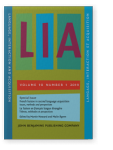The development of obligatory liaison in early L2 learners of French
Studies on the acquisition of French liaison have primarily focused on monolingual children or
adult second language (L2) learners in a university context. To bridge the gap between these two populations, the present article
focuses on child L2 (cL2) learners – a particularly interesting group, since they are L2 learners who, unlike adults, do not have
access to writing. How does liaison develop in cL2 French? Is the
development more similar to L1 or L2 acquisition? These questions are explored through longitudinal data from cL2 learners (age of
onset: 3;0–3;5, n = 3), with monolingual (n = 2) and bilingual (n = 3) L1
controls. The cL2 data present certain similarities with adult L2 learners, but also with L1 controls. However, productions vary
greatly within the L2 group: whereas one of the three learners shows clear development over time, behaving similarly to the L1
children at the end of the observation period, another learner hardly produces any liaisons at all.
Article outline
- 1.Introduction
- 2.Previous studies on the acquisition of liaison
- 2.1L1 acquisition of liaison
- 2.2Second language acquisition of liaison
- 2.3Comparing L1 and L2 acquisition
- 2.4Aim and research questions
- 3.Method
- 3.1Participants
- 3.2Material
- 3.3Analysis
- 4.Results
- 4.1Results for monolingual and bilingual controls
- 4.2Results for the cL2 learners
- 4.2.1Naomi (AoA: 3;4)
- 4.2.2Isa (AoA: 3;5)
- 4.2.3Fia (AoA: 3;0)
- 4.2.4A possible developmental path
- 4.3Comparing the cL2 learners and the controls
- 4.4Comparison with previous studies
- 5.Discussion
- Acknowledgements
- Notes
-
References
